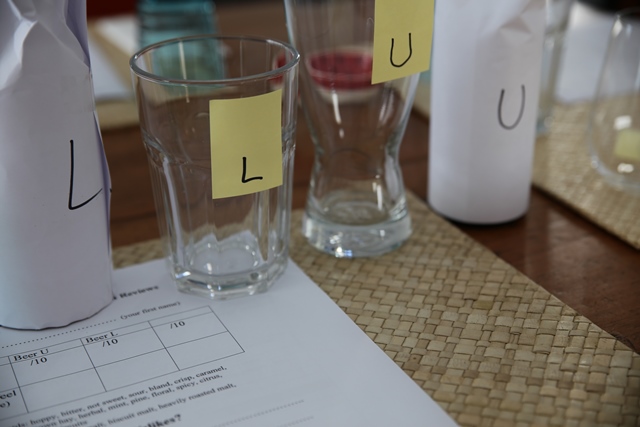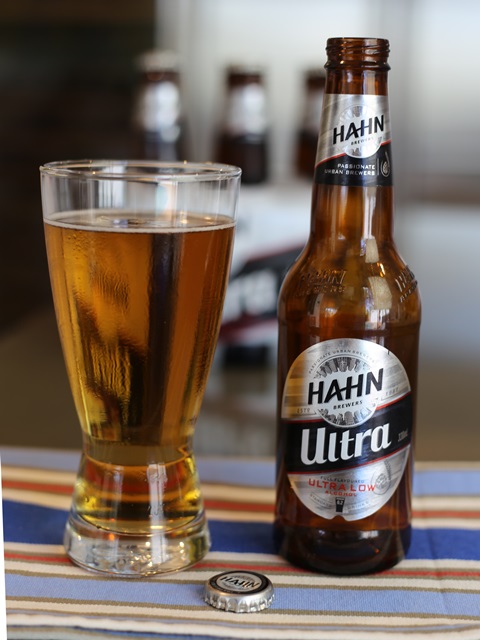Product Snapshot: Hahn Ultra beer
Written by Catherine Saxelby
on Wednesday, 02 March 2016.
Tagged: drinks, Product snapshot, review

Sick of sweet, fizzy drinks or mocktails at the club when you don’t want to drink any alcohol? Want to get a good night’s sleep and be on top of things the next morning but still enjoy a beer out with friends? Then listen up – there’s a new beer on the market with only 0.9 per cent alcohol but with the full flavour and good taste of full-strength beer.
So what is it?
I’m talking about Hahn Ultra. A new beer with an extremely low level of alcohol – under 1 per cent. Normal, full-strength, beers have 4 to 6 per cent, while mid-strength or light beers are around the 2 to 3 per cent mark. So this new beer is a game changer for the Aussie scene which has previously only seen a lower alcohol range of under 3 per cent.
Here’s how the alcohol in beer compares:
| Regular (full-strength) 4-5 % | e.g. Toohey’s New, Toohey’s Extra Dry, James Boag Premium, James Squire 150 Lashes |
| Low carb 4-5% | e.g. Hahn Super Dry |
| Mid-strength 3-4% | e.g Hahn 3.5, XXXX Gold, Pure Blonde, Stella Artois Légére |
| Low alcohol 2-3 % | e.g. Hahn Premium Light, James Boag Premium Light, Cascade Premium Light, Light Ice |
| Ultra Low Less than 1% | e.g. Hahn Ultra plus imported beers such as Schlossgold, Weihenstephan, Clausthaler, Höpman and Beck's. |
Note: the Australian government defines beers as Full strength 4.8%, Mid strength 3.5% and Low strength 2.7%, with red wine at 13%.
Taste test

They were asked to rate Beer U up against Beer L and had no way of knowing which was which as I’d wrapped the bottles up in paper earlier, so it was a proper blind tasting.
The tasters were told this was a light beer-tasting, with one beer having less alcohol than the other but they didn’t know which was which. Half of my six tasters preferred Hahn Ultra and the other half liked the other beer more. This makes me think that they’d happily drink it if they knew it was full-flavoured and would not really affect their overall blood alcohol level.
Perhaps the results may have differed if I had polled a group of light beer drinkers who regularly drink and like lighter beers. The varied feedback from the taste test shows that low alcohol beer might not be for everyone but it clearly has a role in the lesser alcohol ratings.
Pros
- Great full-flavour taste with no loss of flavour. This is a good-tasting beer that will refresh you.
- Easy to drink and refreshing mouth taste.
- The branding is decidedly smart and masculine with strong men’s colours of black and white with a dash of red. I like it as it will encourage blokes to order easily without fear of embarrassment or ‘looking too sissy’. Just order “a Hahn Ultra, thanks mate.” and you’re still ‘one of the lads’.
- Slightly lower price which encourages the trend away from alcohol. The recommended retail price for a slab of 24 bottles is $37.99 which is less than similar other Hahn beers.
Cons
- The flavour fades as the beer clears through the back of your throat. You get a full refreshing initial burst but then it lessens as you drink more. This is because you don’t get the same mouth-feel that you get from a higher ABV beer.
- If you leave the beer poured, you lose a bit of the flavour on standing – but you could also say that for many beers.
- Easy to drink! Soft and pleasant but doesn’t have the oomph of higher-alcohol beers.
- Two of my tasters noted a slight after-taste which they described as ‘metallic’. But overall they considered it a refreshing and flavoursome beer with many positives and were not unhappy with it.
Nutrition stats
Hahn Ultra is pretty impressive. A 330 mL bottle has only 0.2 standard drinks and a tiny 189 kilojoules (45 Calories) which is less than a slice of bread.
That’s because most of the kilojoules are derived from the alcohol, not sugars or carbs. With so little alcohol – a tiny 0.9 per cent compared to 4 or 5 per cent - there are few kilojoules to add to your waistline.
Hahn Ultra has only 0.9 per cent alcohol compared to regular Hahn Super Dry at 4.5 and Hahn Premium Light at 2.6 per cent This is a win-win for beer lovers who can save on kilojoules (Calories) and on alcohol.
Little alcohol means it’s better for your liver - yet you can still be sociable and enjoy a drink when out.
One bottle of Hahn Ultra has only 189 kilojoules (45 Calories) which is less than half that of full-strength beer at 415 kilojoules (99 Calories).
| Component |
Per serve |
Per 100 g |
| Energy, kJ/Cal | 189/45 | 57/14 |
| Protein, g | 0.3 | 0.1 |
| Fat Total, g | <0.7 | <0.2 |
| Saturated, g | <0.3 | <0.1 |
| Carbohydrate, g | 6.1 | 1.8 |
| Sugars, g | 1.0 | 0.3 |
| Dietary Fibre, g | 1.3 | 0.4 |
| Sodium, mg | 9 | 3 |
The bottom line
 Hahn Ultra is a game-changer for lower-alcohol drinks in Australia. For the first time, it gives you a refreshing alternative to non-alcoholic drinks and doesn’t line up with drinks such as diet soft drinks, mocktails and soda-juice combinations.
Hahn Ultra is a game-changer for lower-alcohol drinks in Australia. For the first time, it gives you a refreshing alternative to non-alcoholic drinks and doesn’t line up with drinks such as diet soft drinks, mocktails and soda-juice combinations.
It doesn’t taste sweet so will appeal to anyone with a more savoury palate. It means you can enjoy more than two beers when out without overdoing the alcohol.
I think it will become a light refreshing drink you can dip into when you don’t want to be affected by alcohol – or just want a thirst-quenching option.
Footnote
Catherine was a media spokesperson for the launch of Hahn Ultra and has served on the Lion Beer Advisory Board which oversaw the introduction of full nutrition labelling on over 70 brands of beers.
You may also be interested in...
Like to have your product reviewed by Catherine?
 This post was researched and written by Catherine Saxelby, an accredited nutritionist, dietitian, author and award-winning food communicator. Catherine's goal is to help busy working women eat well, maintain a healthy weight and boost their energy.
This post was researched and written by Catherine Saxelby, an accredited nutritionist, dietitian, author and award-winning food communicator. Catherine's goal is to help busy working women eat well, maintain a healthy weight and boost their energy.
Checkout Catherine’s other posts, books and product reviews or sign up for her free Foodwatch newsletter. To have your product or service reviewed by Catherine and her team, click here.
Sign up for Catherine's free Foodwatch newsletter
About the Author
Catherine Saxelby has the answers! She is an accredited nutritionist, blogger and award-winning author. Her award-winning book My Nutritionary will help you cut through the jargon. Do you know your MCTs from your LCTs? How about sterols from stanols? What’s the difference between glucose and dextrose? Or probiotics and prebiotics? What additive is number 330? How safe is acesulfame K? If you find yourself confused by food labels, grab your copy of Catherine Saxelby’s comprehensive guide My Nutritionary NOW!
The Good Stuff
The Boring Stuff
© 2023 Foodwatch Australia. All rights reserved
Author photo by Kate Williams
Website by Joomstore eCommerce










